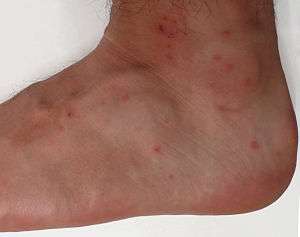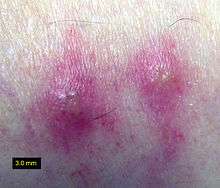Trombiculosis
| Trombiculosis | |
|---|---|
 | |
| Chigger bites on the foot and ankle | |
| Classification and external resources | |
| ICD-10 | B88.0 (ILDS B88.010) |
| ICD-9-CM | 133.8 |
| MeSH | D014323 |
Trombiculosis, trombiculiasis, or trombiculidiasis is a rash caused by trombiculid mites[1] which is often referred to as a chigger bite.
Prevention
Chiggers are commonly found on the tip of blades of grasses to catch a host, so keeping grass short, and removing brush and wood debris where potential mite hosts may live, can limit their impact on an area. Sunlight that penetrates the grass will make the lawn drier and make it less favorable for chigger survival.
Chiggers seem to affect warm covered areas of the body more than drier areas.[2][3] Thus, the bites are often clustered behind the knees, or beneath tight undergarments such as socks, underwear, or brassieres. Areas higher in the body (chest, back, waist-band, and under-arms) are affected more easily in small children than in adults, since children are shorter and are more likely than adults to come in contact with low-lying vegetation and dry grass where chiggers thrive. An exceptional case has been described in the eye,[4] producing conjunctivitis.
Application of repellent to the shoes, lower trousers and skin is also useful. Because they are found in grass, staying on trails, roads, or paths can prevent contact. Dusting sulfur is used commercially for mite control and can be used to control chiggers in yards. The dusting of shoes, socks and trouser legs with sulfur can be highly effective in repelling chiggers.[5]
Another good strategy is to recognize the chigger habitat to avoid exposure in the first place. Chiggers in North America thrive late in summer, in dry tall grasses and other thick, unshaded vegetation. Insect repellents containing one of the following active ingredients are recommended: DEET, catnip oil extract (nepetalactone), citronella oil or eucalyptus oil extract. However, in 1993 issue a study reported on tests of two commercial repellents: DEET and citrus oil: "All chiggers exposed on the filter papers treated with DEET died and did not move off the treated papers. None of the chiggers that were placed on papers treated with citrus oil were killed."[6] It was concluded that DEET was more effective than citrus oil.
Chiggers can also be treated using common household vinegar (5% acetic acid).[1]
Treatment

To reduce the itching, an application of anti-itch cream containing hydrocortisone, calamine, or benzyl benzoate is often used (though calamine has been shown not to be effective). Hydrogen peroxide and capsaicin cream has also been effective. Another good way to relieve itching is to apply heat—either by using a hand held shower with water hot as one can stand, or by heating the bite with a hair dryer. The heat method will relieve itching for about four hours and will require repeating.[7]
In some cases, the chigger is still present when the bite appears. A 10× magnifier can be used to see the chigger and it may be removed with fine-tipped tweezers. Once it is gone, covering the bite with nail polish, calamine lotion, vaseline or other petroleum jelly, baby oil, or anything else may help the pain and itching, but will neither suffocate the chigger nor help the bites heal any faster. Medication such as antihistamines or corticosteroid creams may be prescribed by doctors, and might help in some instances.[8]
References
- 1 2 Baumann T (March 2001). "New treatment for harvest mite infestation". Archives of Internal Medicine. 161 (5): 769. doi:10.1001/archinte.161.5.769. PMID 11231715.
- ↑ "ArmaXX Pest Control". Retrieved 2008-06-24.
- ↑ Ogg, Barb. "Itchy Chiggers". Retrieved 2009-05-19.
- ↑ Parcell, B. J., Sharpe, G., Jones, B. & Alexander, C. L. 2013: Conjunctivitis induced by a red bodied mite, Neotrombicula autumnalis. Parasite, 20, 25. doi:10.1051/parasite/2013025
- ↑ M Bennett, Stuart (2003). "Mites". Self published by author. Retrieved 2009-05-19.
- ↑ Ho TM, Fauziah MK (March 1993). "Laboratory evaluation of two commercial repellents against Leptotrombidium fletcheri (Acari: Trombiculidae)". Southeast Asian Journal of Tropical Medicine and Public Health. 24 (1): 165–9. PMID 8362291.
- ↑ "Harvest mite infestation in cats". Feline Advisory Bureau. November 2008. Retrieved 2013-09-28.
- ↑ Schalock, Peter C. (Last full review/revision December 2006). "Itching: itching and Noninfectious rashes". The Merk Manuals Medical Library. Retrieved 2009-05-19. Check date values in:
|date=(help)